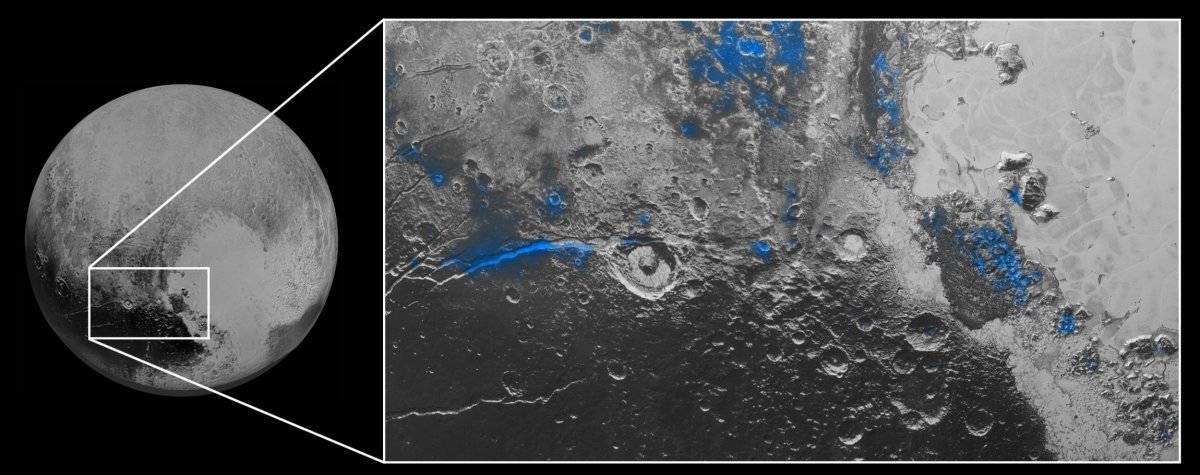
Irving Berlin surely didn't have Pluto in mind when he wrote "Blue Skies" in 1926—four years before the dwarf planet was discovered by astronomer Clyde Tombaugh—and it's unlikely that Ella Fitzgerald, Frank Sinatra, Willie Nelson or any of the other artists who have recorded a version were thinking of Pluto as they sang. But on Thursday, NASA released its first color images of Pluto's atmospheric hazes, which show a glowing halo of blue surrounding the dwarf planet.
"It was surprising to us all when we saw that image...and realized that Pluto has blue skies," says Curt Niebur, program scientist on the New Horizons mission at NASA headquarters. "It's rather heartwarming and homelike to see that there's another planet in the solar system that has the friendly blue skies we're so used to on Earth," he adds, even though the process scientists believe creates the blue color on Pluto is different from the one that does so on Earth.
Niebur and his colleagues believe that ultraviolet light from the sun breaks apart the molecules of gases like methane and nitrogen in Pluto's upper atmosphere. The molecules then recombine to form particles called tholins, which are essentially like smog or soot. When these tholins drift down through the atmosphere, Niebur explains, other gases collect on them like ice frost, or "very tiny, tiny snow," and scatter light so that it appears blue.
"A blue sky often results from scattering of sunlight by very small particles," Carly Howett, a science team researcher, is quoted as saying in NASA's press release. "On Earth, those particles are very tiny nitrogen molecules. On Pluto, they appear to be larger—but still relatively small—soot-like particles we call tholins."
This kind of tholin production occurs at an enormous place on Titan, Saturn's largest moon, Niebur says. Like Pluto, Titan has three components essential to the process: atmospheric gases like methane and nitrogen, extremely low temperatures and sufficient ultraviolet light. Though scientists had previously discussed whether or not the same process could be taking place on Pluto, this image—captured by the spacecraft as it looked back toward Pluto after zooming past the dwarf planet on July 14—is the first evidence they have seen.
"I think the biggest surprise to us has been that even as far as Pluto is—it's the most distant object we've explored—the ultraviolet light from the sun is still strong enough to be powering these kind of chemical reactions," Niebur says.
"It's just another facet of the puzzle that is Pluto, where we were expecting this dead, distant, dreary, dark, cold object where nothing ever changed. But instead what New Horizons has shown us," he adds, is that Pluto is far from static. "Pluto's atmosphere has proven to be far more complex and active than we ever thought it could be."
If blue skies were not enough excitement for one day, NASA also released evidence of water ice on the surface of Pluto. Scientists have long thought that the bedrock of Pluto would be composed of water ice, and evidence of mountains released just one day after the historic flyby this summer led them to believe those must be made out of water ice, since no other material would be strong enough to form such features.

Water ice is exactly what it sounds like, Niebur explains: frozen H2O. But at temperatures around 400 degrees Fahrenheit below zero, "this is not like an ice cube you take out of your freezer," Niebur says. "If you hit it with a hammer, it's not going to break into tiny pieces. This is ice that behaves like a solid rock."
Data collected by the Ralph instrument on board the New Horizons spacecraft—which uses spectroscopy to identify the composition of materials—and analyzed by scientists back on Earth revealed areas of exposed water ice on the surface of Pluto.
"Large expanses of Pluto don't show exposed water ice," science team member Jason Cook is quoted as saying in NASA's press release, "because it's apparently masked by other, more volatile ices across most of the planet. Understanding why water appears exactly where it does, and not in other places, is a challenge that we are digging into."
In addition, the scientists were surprised to find that the regions where Ralph identified the clearest evidence of water ice are the same areas that recent color images showed were red. "I'm surprised that this water ice is so red. We don't yet understand the relationship between water ice and the reddish tholin colorants on Pluto's surface," Silvia Protopapa, a science team member from the University of Maryland, College Park, is quoted as saying in the press release.
"As confident as we get in our knowledge of the solar system, the solar system continues to surprise us," Niebur says. "There's such wonderful diversity and such wonderful complexity out there, even all the way at the edge of our solar system." And as for new data from New Horizons, "there's more to come. This is going to keep happening every week for the next year."
Uncommon Knowledge
Newsweek is committed to challenging conventional wisdom and finding connections in the search for common ground.
Newsweek is committed to challenging conventional wisdom and finding connections in the search for common ground.
About the writer
Stav is a general assignment staff writer for Newsweek. She received the Newswomen's Club of New York's 2016 Martha Coman Front ... Read more
To read how Newsweek uses AI as a newsroom tool, Click here.






